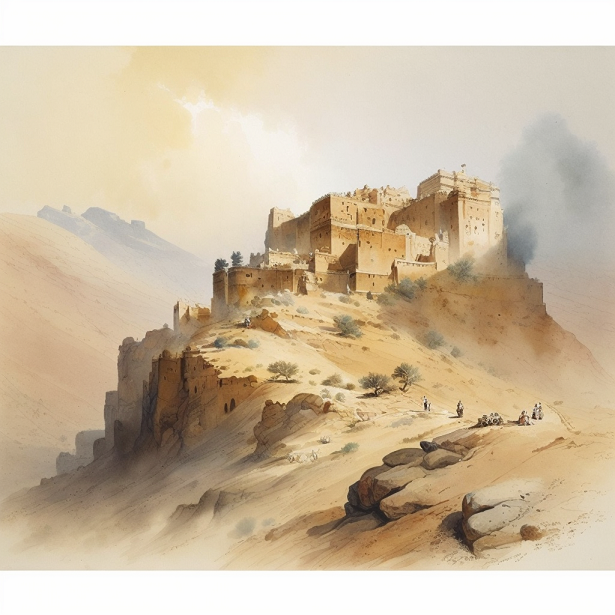“Seen in the Yemen” is a remarkable travelogue that offers readers a unique glimpse into the captivating world of Yemen during the 1970s. Co-authored by Hugh Leach and Freya Stark, this book is a testament to both the wonders of the Yemeni landscape and the indomitable spirit of the legendary traveller Freya Stark. Through this collaboration, the book captures the essence of Yemen’s rich cultural heritage, its stunning natural beauty, and the historical significance that has shaped the region. Freya Stark’s contributions to “Seen in the Yemen” further solidify her reputation as a pioneering figure in travel writing, adding another vibrant thread to the tapestry of her extensive literary works that continue to inspire adventurers and readers alike.
The Unlikely Friendship
The foundation of “Seen in the Yemen” is not only its portrayal of the Yemeni landscapes but also the intriguing friendship between its co-authors, Hugh Leach and Freya Stark. Leach opens this section with a heartwarming account of how his journey with Stark began in the autumn of 1975 when they first crossed paths at Stark’s residence in Asolo, Italy. What transpired from this initial meeting was an incredible adventure as the octogenarian Stark, then eighty-three years old, enthusiastically agreed to embark on a journey with Leach to Yemen. The two explorers ventured into northern Yemen, retracing the steps of Freya Stark, who had visited the region in 1940 during her service as a British intelligence officer. Her mission was to showcase British films to influential Yemeni figures, countering Fascist propaganda that portrayed Britain as nearing defeat. This expedition and its historical echoes serve as a testament to Freya Stark’s indomitable spirit and her pivotal role in the British war effort.
In the Footsteps of a Legendary Explorer
Freya Stark’s enduring influence as a pioneering explorer of the Arabian Peninsula is palpable throughout “Seen in the Yemen”. Her earlier visit to Yemen in 1940, which involved a mission to counter Fascist propaganda, provided her with a unique perspective. Her return to Yemen in the company of Hugh Leach, over three decades later, presented an opportunity to retrace her steps and witness how the landscape and people had evolved. This reunion of time and place offers readers an extraordinary glimpse into the resilience and enduring allure of Yemen. Just as Stark sought to dispel misconceptions about Britain during World War II, Leach’s photographs and their accompanying narratives continue the legacy of promoting cross-cultural understanding.
A Captivating Photographic Odyssey
“Seen in the Yemen” is a visual testament to the exquisite beauty and diversity of Yemen. Through Hugh Leach’s masterful lens, the reader embarks on a mesmerising journey through the country’s landscapes, capturing moments of everyday life that resonate with timeless authenticity. The photography reflects the complex blend of history, culture, and tradition in Yemen. Each image unveils architectural marvels, intricate stucco work, and finely carved details adorning the structures. Moreover, the photographs reveal the human tapestry of Yemen, with men, women, and children, engrossed in daily rituals or caught in candid moments. From bustling souks to tranquil villages, Leach’s evocative pictures lead us into the heart of Yemen, inviting us to revel in its charm and mystique.
A Journey Through the Central Highlands
The Central Highlands of Yemen, with their stunning landscapes and timeless villages, become the focus of Leach’s camera in this segment of the book. An immersive journey through the picturesque highlands unfolds as we venture through this remarkable region. A double-page photograph captures the extraordinary hill-top village of Bait Baws, perched precariously on a vast stone outcrop. Its houses, blending seamlessly with the rock-face, create an otherworldly scene. In the fading light of dusk, four women standing in the thickening air, one clutching a shawl to her face, convey a sense of resilience and the unyielding connection between the people and their surroundings. This chapter brings to life the captivating beauty and enduring traditions of Yemen’s Central Highlands.
The Enigmatic Tihāmah
In the following section, we journey to the Tihāmah, where the town of Zabīd takes centre stage. This coastal lowland area, defined by its unique character, provides a vivid backdrop for Leach’s lens. Here, we encounter a solitary figure walking down a dusty alleyway in Zabīd, carrying a kettle in one hand and balancing a wicker bed on his head. His figure seems to blur into the background, evoking the sense of perpetual movement in these ancient streets.
Sa’dah: Capturing Jewish Life
One of the most historically significant sections of “Seen in the Yemen” is dedicated to the town of Sa’dah and, more specifically, its Jewish population during the 1970s. Hugh Leach embarked on a journey to this area in 1971, capturing not only the picturesque landscapes but also providing valuable insights into the customs and costumes of the Jewish community living in the lands surrounding Sa’dah.
In these photographs, you’ll witness the daily life of the Jewish inhabitants, their traditional attire, and the unique character of their settlements. Leach’s lens freezes moments in time, offering a glimpse into a world that has undergone significant changes over the years.
Beyond Time and Place
In conclusion, “Seen in the Yemen” is a captivating tribute not only to the enigmatic and picturesque landscapes of Yemen but also to the indomitable spirit of exploration epitomized by Freya Stark. The book, a collaboration between Hugh Leach and Freya Stark, transports readers to a Yemen untouched by modern influences. Through Leach’s lens, the country’s landscapes, cities, and people come alive, offering a window into its unique culture and timeless beauty.

